Home / In Summary: Free Radicals
Free Radical Reactions
In Summary: Free Radicals
Last updated: December 7th, 2022 |
A Summary Of Topics For Free-Radical Reactions
So what have we learned in this series about free radicals? Lots of things. We’ve seen that they are neutral species with a half-filled valence shell that tend to be highly reactive with alkanes and double bonds. We’ve seen that they are stabilized by electron donors and delocalization. We’ve shown their mechanisms proceed through three distinct stages (initiation, propagation, termination) and that although reactions tend to be selective for formation of the more stable free radical, bromine radicals are far more selective than chlorine radicals in halogenation of alkanes. Finally we’ve also explored allylic (and benzylic) halogenation and seen examples of allylic rearrangement.
Table of Contents
- What Are Free Radicals?
- Homolytic Cleavage And “Single-Barbed” Curved Arrows
- Factors That Affect Free Radical Stability
- Factors That Destabilize Free Radicals
- A Handy Shortcut For Determining Radical Stability
- How Do Free Radical Reactions Work? Initiation, Propagation, Termination
- Free-Radical Halogenation Leads To Mixtures Of Isomers – But There Is Some Selectivity
- Bromination Is More Selective Than Chlorination
- Allylic Bromination, And Allylic Bromination With Allylic Rearrangement
- Free-Radical Addition Of Radicals To Alkenes
- Notes
1. What Are Free Radicals?
Free radicals are chemical species that contain a singly occupied orbital. They are neutral and tend to be highly reactive.
One of the most common classes of free-radical reactions is free-radical substitution. Here is an example of the reaction between methane and Cl2:

2. Homolytic Cleavage And “Single-Barbed” Curved Arrows
Unlike many of the reactions we have seen previously, free radical reactions do not involve the donation or acceptance of an electron lone pair and they are not ionic. Instead, free radical reactions operate through homolytic cleavage – that is, bonds break such that equal numbers of electrons are distributed to each atom. The curved arrow formalism is modified here: we draw curved arrows with a single barb, which shows the movement of a single electron:
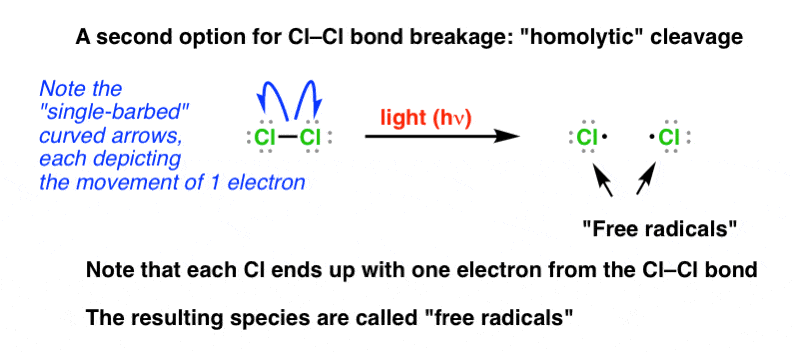
3. Factors That Affect Free Radical Stability
Like carbocations, free radicals are electron-deficient species. [Helpful to know: the factors which affect the stability of free radicals are the same which influence the stability of carbocations.] They can be stabilized through donation of electron density by neighbours; for this reason, radical stability increases in the order methyl < primary < secondary < tertiary . [Radicals are also stabilized by adjacent atoms with lone pairs, such as oxygen and nitrogen]. [See post: 3 Factors Which Stabilize Free Radicals]
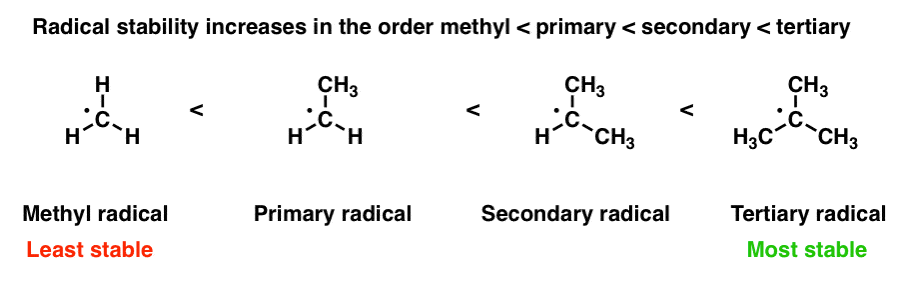
A second important factor which stabilizes free radicals is “delocalization” – that is, if the radical can be spread out over two or more carbons. A more familiar way of saying this is that free radicals are stabilized by resonance.
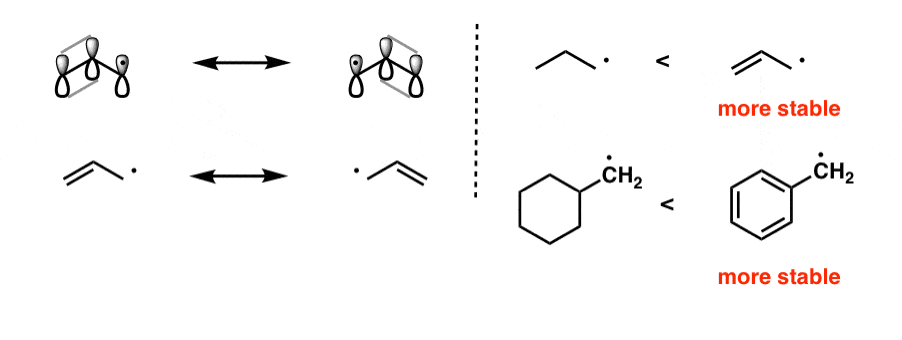
4. Factors That Destabilize Free Radicals
As electron-deficient species, it is also helpful to keep in mind some of the factors which destabilize free radicals. There are several important trends to keep in mind [See post: Which Factors Destabilize Free Radicals?]
- Free radicals decrease in stability as the % of s-character in the orbital increases [i.e. as the half-empty orbital becomes closer to the nucleus]. For that reason, free radical stability decreases as the atom goes from alkyl to alkenyl to alkynyl.
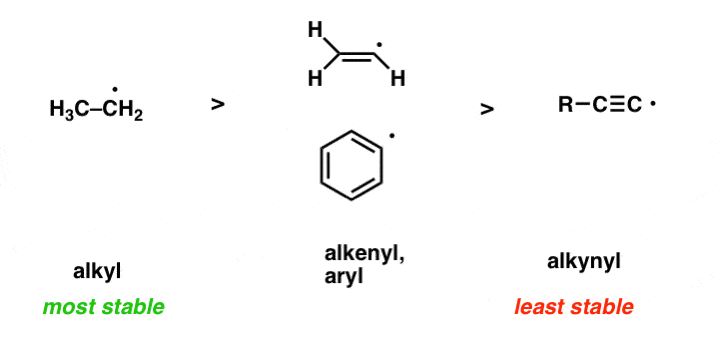
- Across a row of the periodic table, free radicals decrease in stability as the electronegativity increases

- Free radicals increase in stability going down a column of the periodic table, F• < Cl• < Br• < I• since the electron-deficient orbital is spread out over a greater volume.
- Free radicals adjacent to an electron-withdrawing group are less stable, since in effect, electron-density is being taken away from what is already an electron deficient species. [Watch out, however – this only applies to electron withdrawing groups that cannot donate a pair of electrons, like CF3 or CN.]
5. A Handy Shortcut For Determining Radical Stability
Bond dissociation energies [BDE’s] measure the energy required for homolytic bond cleavage, and by proxy we can interpret C–H bond strengths as a good measure of carbon free-radical stability. By examining trends in X-H bond strengths (where X is various atoms) we can discern trends in radical stability. [See post: Bond Strengths and Radical Stability]

This is also reflected in the strengths of “allylic” C-H bonds, which are weaker than normal due to the fact that a resonance-stabilized free-radical is produced. For example, the C-H bond strength of the methyl group of propane is about 98 kcal/mol, whereas that of the methyl group of 1-propene is 85 kcal/mol. For a complete list of factors, refer to the original post.
6. How Do Free Radical Reactions Work? Initiation, Propagation, Termination
One “sure fire” way students find themselves identifying free-radical reactions is to look for the presence of “heat” [ Δ] or “light” [hν ]. What does heat or light have to do with free-radical reactions? Well, it facilitates the first important step in any free radical reaction: initiation. This is the homolytic fragmentation of a weak bond to form two new free radicals. [See post: Free Radical Reactions – Why is “Heat” or “Light” Required?]
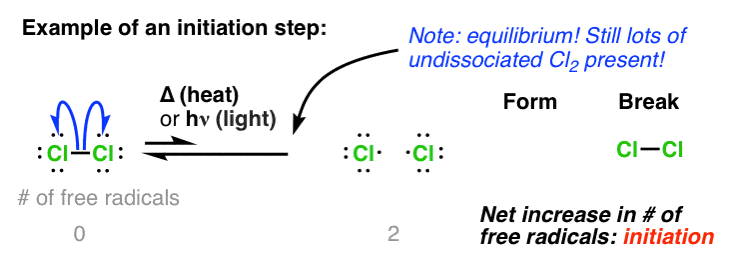
It’s important to note here that “initiation” is not a reaction that goes to completion. At any given point, only a small concentration of the starting material is converted to free radicals. However, since the reaction is a chain-reaction, this is generally sufficient.
The second step in a free-radical process is at least one (but often two) “propagation” steps. For the free-radical halogenation of alkanes, the first propagation step is removal of hydrogen by a halogen radical, giving a new carbon radical. Note here that the number of free radicals remains constant (one on both sides of the equation).
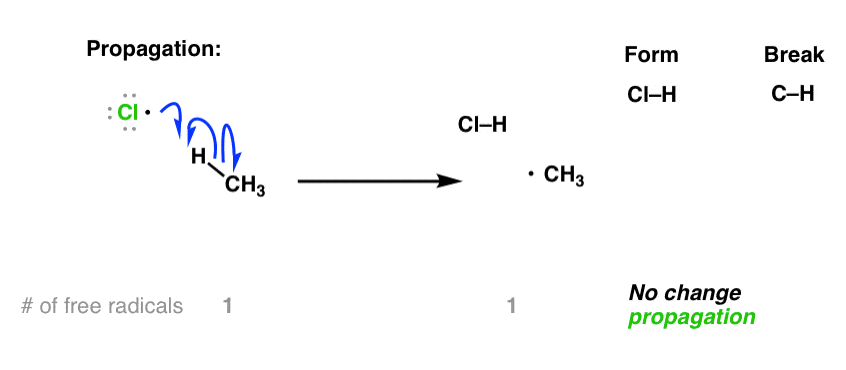
This is followed by a second propagation step. While it may be tempting for many new students to form CH3-Cl through combination of CH3• with a chlorine radical, that’s not what happens next [that would technically be a “termination” step, see below]. What happens next is the reaction of alkyl radical with one of the starting molecules of Cl2, forming a new C–Cl bond and a new Cl• radical which continues the chain reaction. Again, note: no net increase in the number of free radicals here:
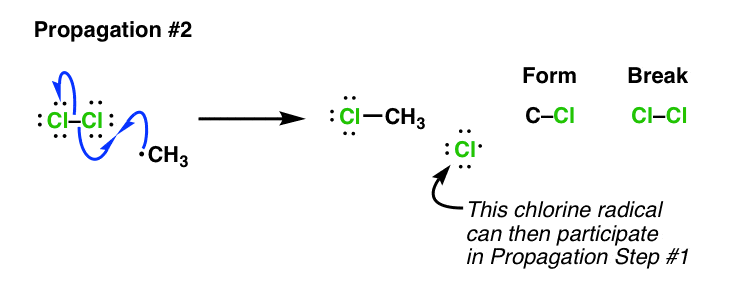
At any given point the concentration of free radicals in solution is quite low. However, after most of the Cl2 is consumed, free-radical concentrations will start to increase until the rate of radical-radical combination reactions is significant. This is called “termination” since it results in a net destruction of free radicals. There are many potential ways this can occur – here is one example:

The bottom line is that by counting the number of radicals created or destroyed in each step you can determine if the step is initiation, propagation, or termination.
[See post: Initiation, Propagation, Termination]
7. Free-Radical Halogenation Leads To Mixtures Of Isomers – But There Is Some Selectivity
Methane and ethanes are simple examples. Replacement of any one of the 4 hydrogens of methane by chlorine will result in the same product. However when we are dealing with a more complex alkane, like propane, butane, or 2,3-dimethyl hexane, we must be alert for the possibility that a variety of compounds will form. It’s an important skill to be able to recognize all the possible compounds that could result from, say, the mono-chlorination of an alkane like 2-methylpentane [there are 5]. These types of questions are best approached systematically: start with replacement of hydrogen by chlorine on one side of the molecule, and gradually work to the other side – it can help to double check that there are no duplicates by trying to name them (IUPAC). [See post: Isomers From Free Radical Reactions]
That being said, isomers will not be formed in equal quantities. There are two factors to consider. The first is the fact that not all C-H bonds are of equal strength; as we mentioned above, tertiary C-H bonds are easier to break than secondary C-H bonds, which are easier to break than primary C-H bonds. So there will be an inherent difference in reactivity between these bonds simply by the fact that it requires less activation energy to break a weaker bond. A second factor is statistics. In propane, for example, there are six primary C-H bonds and two secondary C-H bonds. Based on statistics alone, we would expect mono-chlorination propane to yield a 3:1 ratio of 1-chloropropane to 2-chloropropane.
What’s interesting is that the actual ratio of 2-chloropropane to 1-chloropropane is 45:55 !
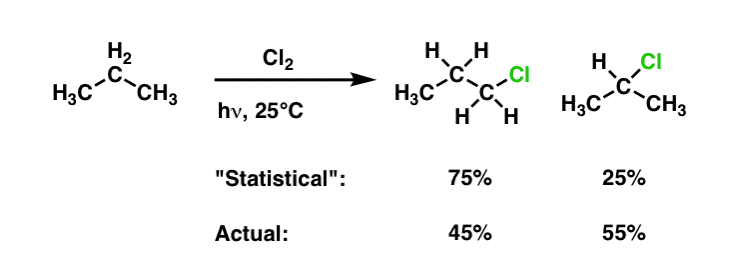
It’s possible to use this information to quantify the reactivity of each type of hydrogen in a molecule. Using the method from this post, we can determine that the secondary C-H is 3.66 times more reactive than the primary C–H under these conditions. [See Post: Selectivity In Free Radical Reactions]
8. Bromination Is More Selective Than Chlorination
Interestingly, bromination of alkanes is even more selective than chlorination for tertiary and secondary C–H bonds. For example in the bromination of propane at 25°C, the reaction is selective for secondary C–H over primary C–H by a factor of 97 to 1 .
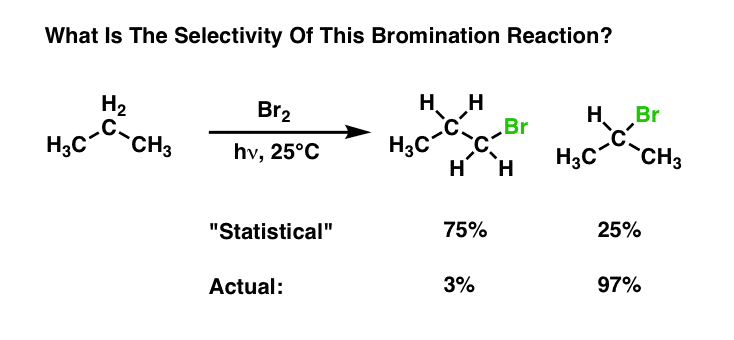
Why the huge difference? The most rigorous way to look at it is to apply Hammond’s Postulate: chlorination is exothermic, bromination is endothermic; therefore, chlorination will have a “reactant-like” transition state and bromination will have a “product-like” transition state. In this case the difference in energies between products is greater than the difference in energies between reactants ; and since selectivity is determined by differences in energies between transition states, therefore, bromination will be more selective than chlorination. If this sounds complex, the full post is here. Alternatively, a simple analogy I use to explain this concept is here. [See Post: Selectivity In Free Radical Reactions – Chlorine vs. Bromine]
9. Allylic Bromination, And Allylic Bromination With Allylic Rearrangement
Weak C–H bonds (like tertiary C–H bonds, for instance) are very easily halogenated. Allylic and benzylic C–H bonds are particularly weak (about 86 kcal/mol) which makes them excellent substrates for bromination reactions. Molecular bromine (Br2) can be useful for benzylic bromination, but attempts to use this reagent with alkenes like, say, propene, would result in formation of a dibromide.
The way around this is to use the useful source of bromonium ion, N-bromo succinimide (NBS), which serves as a dilute source of Br2 . This allows replacement of the allylic C–H bond with Br. This process is called “allylic bromination“.
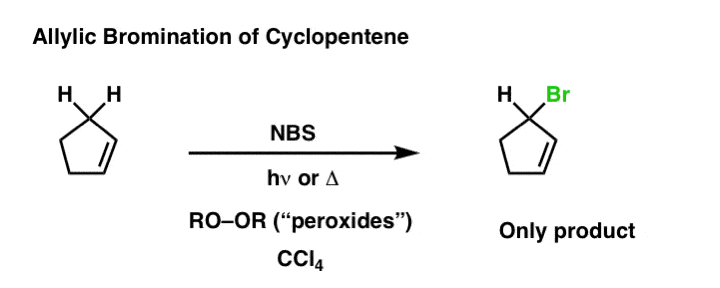
Interestingly, changing the substrate just a little bit can result in some surprising results. The example below differs from the example above by only a single methyl group. However, this can lead to two potential products – the “normal” product of allylic bromination (A) and a closely related product, allylic bromination with allylic rearrangement (B). One factor which can dictate which final product is formed is determining which alkene is more substituted.
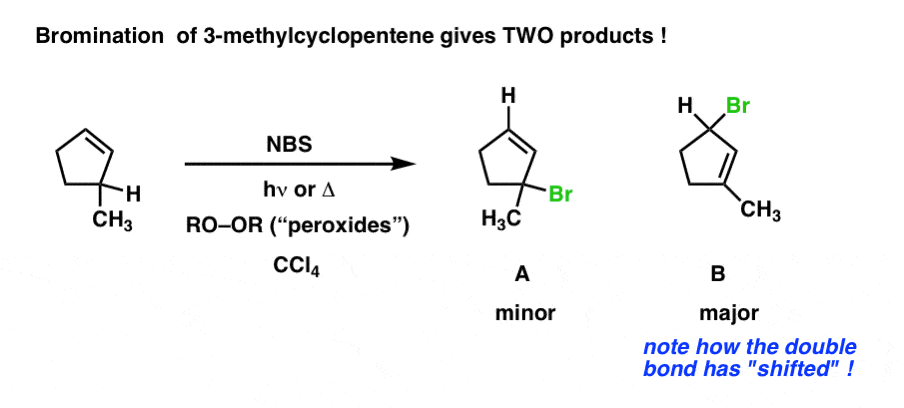
10. Free-Radical Addition Of Radicals To Alkenes
Finally, it’s important to note that H–Br can add to alkenes in a completely different fashion depending whether or not “peroxides” are present. In the absence of peroxides, H-Br adds through a “normal” electrophilic addition [post here – not radical related]. However, if peroxides are added and the mixture is heated, it leads to homolytic cleavage of the peroxide, forming new free radicals (initiation). Peroxide can then remove a hydrogen from H-Br forming the Br• radical, and then Br• can add to alkenes. What’s important to note is that Br• adds to alkenes in a such a way that we end up with the most stable radical intermediate, which then removes hydrogen from H–Br, regenerating bromine radical. The net result is “anti-Markovnikov” addition of H-Br across a double bond, the opposite of what is observed in the absence of peroxides. [full mechanism in this post]
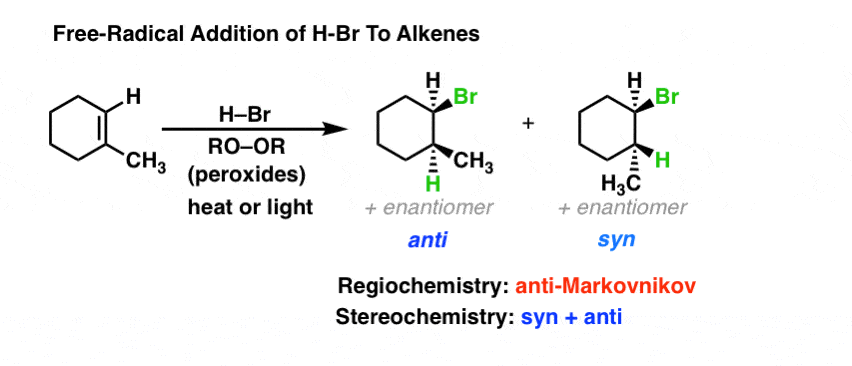
That does it for free radical reactions (for now).
In the next series we’ll start putting a lot of our Org 1 reactions together… and finally delve into one of my favourite topics – synthesis.
Notes
Related Articles
- Bond Dissociation Energies = Homolytic Cleavage
- Free Radical Reactions
- 3 Factors That Stabilize Free Radicals
- Bond Strengths And Radical Stability
- Free Radical Initiation: Why Is “Light” Or “Heat” Required?
- Initiation, Propagation, Termination
- Monochlorination Products Of Propane, Pentane, And Other Alkanes
- Selectivity in Free Radical Reactions: Bromination vs. Chlorination
- Halogenation At Tiffany’s
- Allylic Bromination
- Bonus Topic: Allylic Rearrangements
- Free Radicals Practice Quizzes (MOC Membership required)
Note 1. Related to the addition of H-Br to alkenes, is an interesting process called “free radical polymerization”.
If certain alkenes are heated in the presence of a radical initator (let’s say “peroxides” as a typical example), the peroxy radical can add to the alkene, forming a new free radical on the most substituted position… and the resulting free radical can add to another alkene…. generating another free radical…. which adds to yet another alkene! – and so on.
The process can repeat thousands of times before termination occurs. Some of the most common plastics of daily life can be made this way – such as polyethylene, polypropylene, and polystyrene.
00 General Chemistry Review
01 Bonding, Structure, and Resonance
- How Do We Know Methane (CH4) Is Tetrahedral?
- Hybrid Orbitals and Hybridization
- How To Determine Hybridization: A Shortcut
- Orbital Hybridization And Bond Strengths
- Sigma bonds come in six varieties: Pi bonds come in one
- Dipole Moments and Dipoles
- A Key Skill: How to Calculate Formal Charge
- The Four Intermolecular Forces and How They Affect Boiling Points
- 3 Trends That Affect Boiling Points
- How To Use Electronegativity To Determine Electron Density (and why NOT to trust formal charge)
- Introduction to Resonance
- How To Use Curved Arrows To Interchange Resonance Forms
- Evaluating Resonance Forms (1) - The Rule of Least Charges
- How To Find The Best Resonance Structure By Applying Electronegativity
- Evaluating Resonance Structures With Negative Charges
- Evaluating Resonance Structures With Positive Charge
- Exploring Resonance: Pi-Donation
- Exploring Resonance: Pi-acceptors
- In Summary: Evaluating Resonance Structures
- Drawing Resonance Structures: 3 Common Mistakes To Avoid
- How to apply electronegativity and resonance to understand reactivity
- Bond Hybridization Practice
- Structure and Bonding Practice Quizzes
- Resonance Structures Practice
02 Acid Base Reactions
- Introduction to Acid-Base Reactions
- Acid Base Reactions In Organic Chemistry
- The Stronger The Acid, The Weaker The Conjugate Base
- Walkthrough of Acid-Base Reactions (3) - Acidity Trends
- Five Key Factors That Influence Acidity
- Acid-Base Reactions: Introducing Ka and pKa
- How to Use a pKa Table
- The pKa Table Is Your Friend
- A Handy Rule of Thumb for Acid-Base Reactions
- Acid Base Reactions Are Fast
- pKa Values Span 60 Orders Of Magnitude
- How Protonation and Deprotonation Affect Reactivity
- Acid Base Practice Problems
03 Alkanes and Nomenclature
- Meet the (Most Important) Functional Groups
- Condensed Formulas: Deciphering What the Brackets Mean
- Hidden Hydrogens, Hidden Lone Pairs, Hidden Counterions
- Don't Be Futyl, Learn The Butyls
- Primary, Secondary, Tertiary, Quaternary In Organic Chemistry
- Branching, and Its Affect On Melting and Boiling Points
- The Many, Many Ways of Drawing Butane
- Wedge And Dash Convention For Tetrahedral Carbon
- Common Mistakes in Organic Chemistry: Pentavalent Carbon
- Table of Functional Group Priorities for Nomenclature
- Summary Sheet - Alkane Nomenclature
- Organic Chemistry IUPAC Nomenclature Demystified With A Simple Puzzle Piece Approach
- Boiling Point Quizzes
- Organic Chemistry Nomenclature Quizzes
04 Conformations and Cycloalkanes
- Staggered vs Eclipsed Conformations of Ethane
- Conformational Isomers of Propane
- Newman Projection of Butane (and Gauche Conformation)
- Introduction to Cycloalkanes
- Geometric Isomers In Small Rings: Cis And Trans Cycloalkanes
- Calculation of Ring Strain In Cycloalkanes
- Cycloalkanes - Ring Strain In Cyclopropane And Cyclobutane
- Cyclohexane Conformations
- Cyclohexane Chair Conformation: An Aerial Tour
- How To Draw The Cyclohexane Chair Conformation
- The Cyclohexane Chair Flip
- The Cyclohexane Chair Flip - Energy Diagram
- Substituted Cyclohexanes - Axial vs Equatorial
- Ranking The Bulkiness Of Substituents On Cyclohexanes: "A-Values"
- Cyclohexane Chair Conformation Stability: Which One Is Lower Energy?
- Fused Rings - Cis-Decalin and Trans-Decalin
- Naming Bicyclic Compounds - Fused, Bridged, and Spiro
- Bredt's Rule (And Summary of Cycloalkanes)
- Newman Projection Practice
- Cycloalkanes Practice Problems
05 A Primer On Organic Reactions
- The Most Important Question To Ask When Learning a New Reaction
- Curved Arrows (for reactions)
- Nucleophiles and Electrophiles
- The Three Classes of Nucleophiles
- Nucleophilicity vs. Basicity
- What Makes A Good Nucleophile?
- What Makes A Good Leaving Group?
- 3 Factors That Stabilize Carbocations
- Equilibrium and Energy Relationships
- 7 Factors that stabilize negative charge in organic chemistry
- 7 Factors That Stabilize Positive Charge in Organic Chemistry
- What's a Transition State?
- Hammond's Postulate
- Learning Organic Chemistry Reactions: A Checklist (PDF)
06 Free Radical Reactions
- Free Radical Reactions
- 3 Factors That Stabilize Free Radicals
- Bond Strengths And Radical Stability
- Free Radical Initiation: Why Is "Light" Or "Heat" Required?
- Initiation, Propagation, Termination
- Monochlorination Products Of Propane, Pentane, And Other Alkanes
- Selectivity In Free Radical Reactions
- Selectivity in Free Radical Reactions: Bromination vs. Chlorination
- Halogenation At Tiffany's
- Allylic Bromination
- Bonus Topic: Allylic Rearrangements
- In Summary: Free Radicals
- Synthesis (2) - Reactions of Alkanes
- Free Radicals Practice Quizzes
07 Stereochemistry and Chirality
- Types of Isomers: Constitutional Isomers, Stereoisomers, Enantiomers, and Diastereomers
- How To Draw The Enantiomer Of A Chiral Molecule
- How To Draw A Bond Rotation
- Introduction to Assigning (R) and (S): The Cahn-Ingold-Prelog Rules
- Assigning Cahn-Ingold-Prelog (CIP) Priorities (2) - The Method of Dots
- Enantiomers vs Diastereomers vs The Same? Two Methods For Solving Problems
- Assigning R/S To Newman Projections (And Converting Newman To Line Diagrams)
- How To Determine R and S Configurations On A Fischer Projection
- The Meso Trap
- Optical Rotation, Optical Activity, and Specific Rotation
- Optical Purity and Enantiomeric Excess
- What's a Racemic Mixture?
- Chiral Allenes And Chiral Axes
- Stereochemistry Practice Problems and Quizzes
08 Substitution Reactions
- Nucleophilic Substitution Reactions - Introduction
- Two Types of Nucleophilic Substitution Reactions
- The SN2 Mechanism
- Why the SN2 Reaction Is Powerful
- The SN1 Mechanism
- The Conjugate Acid Is A Better Leaving Group
- Comparing the SN1 and SN2 Reactions
- Polar Protic? Polar Aprotic? Nonpolar? All About Solvents
- Steric Hindrance is Like a Fat Goalie
- Common Blind Spot: Intramolecular Reactions
- Substitution Practice - SN1
- Substitution Practice - SN2
09 Elimination Reactions
- Elimination Reactions (1): Introduction And The Key Pattern
- Elimination Reactions (2): The Zaitsev Rule
- Elimination Reactions Are Favored By Heat
- Two Elimination Reaction Patterns
- The E1 Reaction
- The E2 Mechanism
- E1 vs E2: Comparing the E1 and E2 Reactions
- Antiperiplanar Relationships: The E2 Reaction and Cyclohexane Rings
- Bulky Bases in Elimination Reactions
- Comparing the E1 vs SN1 Reactions
- Elimination (E1) Reactions With Rearrangements
- E1cB - Elimination (Unimolecular) Conjugate Base
- Elimination (E1) Practice Problems And Solutions
- Elimination (E2) Practice Problems and Solutions
10 Rearrangements
11 SN1/SN2/E1/E2 Decision
- Identifying Where Substitution and Elimination Reactions Happen
- Deciding SN1/SN2/E1/E2 (1) - The Substrate
- Deciding SN1/SN2/E1/E2 (2) - The Nucleophile/Base
- SN1 vs E1 and SN2 vs E2 : The Temperature
- Deciding SN1/SN2/E1/E2 - The Solvent
- Wrapup: The Key Factors For Determining SN1/SN2/E1/E2
- Alkyl Halide Reaction Map And Summary
- SN1 SN2 E1 E2 Practice Problems
12 Alkene Reactions
- E and Z Notation For Alkenes (+ Cis/Trans)
- Alkene Stability
- Alkene Addition Reactions: "Regioselectivity" and "Stereoselectivity" (Syn/Anti)
- Stereoselective and Stereospecific Reactions
- Hydrohalogenation of Alkenes and Markovnikov's Rule
- Hydration of Alkenes With Aqueous Acid
- Rearrangements in Alkene Addition Reactions
- Halogenation of Alkenes and Halohydrin Formation
- Oxymercuration Demercuration of Alkenes
- Hydroboration Oxidation of Alkenes
- m-CPBA (meta-chloroperoxybenzoic acid)
- OsO4 (Osmium Tetroxide) for Dihydroxylation of Alkenes
- Palladium on Carbon (Pd/C) for Catalytic Hydrogenation of Alkenes
- Cyclopropanation of Alkenes
- A Fourth Alkene Addition Pattern - Free Radical Addition
- Alkene Reactions: Ozonolysis
- Oxidative Cleavage of Vicinal Diols With NaIO4 and Pb(OAc)4
- Summary: Three Key Families Of Alkene Reaction Mechanisms
- Synthesis (4) - Alkene Reaction Map, Including Alkyl Halide Reactions
- Alkene Reactions Practice Problems
13 Alkyne Reactions
- Acetylides from Alkynes, And Substitution Reactions of Acetylides
- Partial Reduction of Alkynes With Lindlar's Catalyst
- Partial Reduction of Alkynes With Na/NH3 To Obtain Trans Alkenes
- Alkyne Hydroboration With "R2BH"
- Hydration and Oxymercuration of Alkynes
- Hydrohalogenation of Alkynes
- Alkyne Halogenation: Bromination and Chlorination of Alkynes
- Oxidation of Alkynes With O3 and KMnO4
- Alkenes To Alkynes Via Halogenation And Elimination Reactions
- Alkynes Are A Blank Canvas
- Synthesis (5) - Reactions of Alkynes
- Alkyne Reactions Practice Problems With Answers
14 Alcohols, Epoxides and Ethers
- Alcohols - Nomenclature and Properties
- Alcohols Can Act As Acids Or Bases (And Why It Matters)
- Alcohols - Acidity and Basicity
- The Williamson Ether Synthesis
- Ethers From Alkenes, Tertiary Alkyl Halides and Alkoxymercuration
- Alcohols To Ethers via Acid Catalysis
- Cleavage Of Ethers With Acid
- Epoxides - The Outlier Of The Ether Family
- Opening of Epoxides With Acid
- Epoxide Ring Opening With Base
- Making Alkyl Halides From Alcohols
- Tosylates And Mesylates
- PBr3 and SOCl2
- Elimination Reactions of Alcohols
- Elimination of Alcohols To Alkenes With POCl3
- Alcohol Oxidation: "Strong" and "Weak" Oxidants
- Demystifying The Mechanisms of Alcohol Oxidations
- Protecting Groups For Alcohols
- Thiols And Thioethers
- Calculating the oxidation state of a carbon
- Oxidation and Reduction in Organic Chemistry
- Oxidation Ladders
- SOCl2 Mechanism For Alcohols To Alkyl Halides: SN2 versus SNi
- Alcohol Reactions Roadmap (PDF)
- Alcohol Reaction Practice Problems
- Epoxide Reaction Quizzes
- Oxidation and Reduction Practice Quizzes
15 Organometallics
- What's An Organometallic?
- Formation of Grignard and Organolithium Reagents
- Organometallics Are Strong Bases
- Reactions of Grignard Reagents
- Protecting Groups In Grignard Reactions
- Synthesis Problems Involving Grignard Reagents
- Grignard Reactions And Synthesis (2)
- Organocuprates (Gilman Reagents): How They're Made
- Gilman Reagents (Organocuprates): What They're Used For
- The Heck, Suzuki, and Olefin Metathesis Reactions (And Why They Don't Belong In Most Introductory Organic Chemistry Courses)
- Reaction Map: Reactions of Organometallics
- Grignard Practice Problems
16 Spectroscopy
- Degrees of Unsaturation (or IHD, Index of Hydrogen Deficiency)
- Conjugation And Color (+ How Bleach Works)
- Introduction To UV-Vis Spectroscopy
- UV-Vis Spectroscopy: Absorbance of Carbonyls
- UV-Vis Spectroscopy: Practice Questions
- Bond Vibrations, Infrared Spectroscopy, and the "Ball and Spring" Model
- Infrared (IR) Spectroscopy: A Quick Primer On Interpreting Spectra
- IR Spectroscopy: 4 Practice Problems
- 1H NMR: How Many Signals?
- Homotopic, Enantiotopic, Diastereotopic
- Diastereotopic Protons in 1H NMR Spectroscopy: Examples
- 13-C NMR - How Many Signals
- Liquid Gold: Pheromones In Doe Urine
- Natural Product Isolation (1) - Extraction
- Natural Product Isolation (2) - Purification Techniques, An Overview
- Structure Determination Case Study: Deer Tarsal Gland Pheromone
17 Dienes and MO Theory
- What To Expect In Organic Chemistry 2
- Are these molecules conjugated?
- Conjugation And Resonance In Organic Chemistry
- Bonding And Antibonding Pi Orbitals
- Molecular Orbitals of The Allyl Cation, Allyl Radical, and Allyl Anion
- Pi Molecular Orbitals of Butadiene
- Reactions of Dienes: 1,2 and 1,4 Addition
- Thermodynamic and Kinetic Products
- More On 1,2 and 1,4 Additions To Dienes
- s-cis and s-trans
- The Diels-Alder Reaction
- Cyclic Dienes and Dienophiles in the Diels-Alder Reaction
- Stereochemistry of the Diels-Alder Reaction
- Exo vs Endo Products In The Diels Alder: How To Tell Them Apart
- HOMO and LUMO In the Diels Alder Reaction
- Why Are Endo vs Exo Products Favored in the Diels-Alder Reaction?
- Diels-Alder Reaction: Kinetic and Thermodynamic Control
- The Retro Diels-Alder Reaction
- The Intramolecular Diels Alder Reaction
- Regiochemistry In The Diels-Alder Reaction
- The Cope and Claisen Rearrangements
- Electrocyclic Reactions
- Electrocyclic Ring Opening And Closure (2) - Six (or Eight) Pi Electrons
- Diels Alder Practice Problems
- Molecular Orbital Theory Practice
18 Aromaticity
- Introduction To Aromaticity
- Rules For Aromaticity
- Huckel's Rule: What Does 4n+2 Mean?
- Aromatic, Non-Aromatic, or Antiaromatic? Some Practice Problems
- Antiaromatic Compounds and Antiaromaticity
- The Pi Molecular Orbitals of Benzene
- The Pi Molecular Orbitals of Cyclobutadiene
- Frost Circles
- Aromaticity Practice Quizzes
19 Reactions of Aromatic Molecules
- Electrophilic Aromatic Substitution: Introduction
- Activating and Deactivating Groups In Electrophilic Aromatic Substitution
- Electrophilic Aromatic Substitution - The Mechanism
- Ortho-, Para- and Meta- Directors in Electrophilic Aromatic Substitution
- Understanding Ortho, Para, and Meta Directors
- Why are halogens ortho- para- directors?
- Disubstituted Benzenes: The Strongest Electron-Donor "Wins"
- Electrophilic Aromatic Substitutions (1) - Halogenation of Benzene
- Electrophilic Aromatic Substitutions (2) - Nitration and Sulfonation
- EAS Reactions (3) - Friedel-Crafts Acylation and Friedel-Crafts Alkylation
- Intramolecular Friedel-Crafts Reactions
- Nucleophilic Aromatic Substitution (NAS)
- Nucleophilic Aromatic Substitution (2) - The Benzyne Mechanism
- Reactions on the "Benzylic" Carbon: Bromination And Oxidation
- The Wolff-Kishner, Clemmensen, And Other Carbonyl Reductions
- More Reactions on the Aromatic Sidechain: Reduction of Nitro Groups and the Baeyer Villiger
- Aromatic Synthesis (1) - "Order Of Operations"
- Synthesis of Benzene Derivatives (2) - Polarity Reversal
- Aromatic Synthesis (3) - Sulfonyl Blocking Groups
- Birch Reduction
- Synthesis (7): Reaction Map of Benzene and Related Aromatic Compounds
- Aromatic Reactions and Synthesis Practice
- Electrophilic Aromatic Substitution Practice Problems
20 Aldehydes and Ketones
- What's The Alpha Carbon In Carbonyl Compounds?
- Nucleophilic Addition To Carbonyls
- Aldehydes and Ketones: 14 Reactions With The Same Mechanism
- Sodium Borohydride (NaBH4) Reduction of Aldehydes and Ketones
- Grignard Reagents For Addition To Aldehydes and Ketones
- Wittig Reaction
- Hydrates, Hemiacetals, and Acetals
- Imines - Properties, Formation, Reactions, and Mechanisms
- All About Enamines
- Breaking Down Carbonyl Reaction Mechanisms: Reactions of Anionic Nucleophiles (Part 2)
- Aldehydes Ketones Reaction Practice
21 Carboxylic Acid Derivatives
- Nucleophilic Acyl Substitution (With Negatively Charged Nucleophiles)
- Addition-Elimination Mechanisms With Neutral Nucleophiles (Including Acid Catalysis)
- Basic Hydrolysis of Esters - Saponification
- Transesterification
- Proton Transfer
- Fischer Esterification - Carboxylic Acid to Ester Under Acidic Conditions
- Lithium Aluminum Hydride (LiAlH4) For Reduction of Carboxylic Acid Derivatives
- LiAlH[Ot-Bu]3 For The Reduction of Acid Halides To Aldehydes
- Di-isobutyl Aluminum Hydride (DIBAL) For The Partial Reduction of Esters and Nitriles
- Amide Hydrolysis
- Thionyl Chloride (SOCl2) And Conversion of Carboxylic Acids to Acid Halides
- Diazomethane (CH2N2)
- Carbonyl Chemistry: Learn Six Mechanisms For the Price Of One
- Making Music With Mechanisms (PADPED)
- Carboxylic Acid Derivatives Practice Questions
22 Enols and Enolates
- Keto-Enol Tautomerism
- Enolates - Formation, Stability, and Simple Reactions
- Kinetic Versus Thermodynamic Enolates
- Aldol Addition and Condensation Reactions
- Reactions of Enols - Acid-Catalyzed Aldol, Halogenation, and Mannich Reactions
- Claisen Condensation and Dieckmann Condensation
- Decarboxylation
- The Malonic Ester and Acetoacetic Ester Synthesis
- The Michael Addition Reaction and Conjugate Addition
- The Robinson Annulation
- Haloform Reaction
- The Hell–Volhard–Zelinsky Reaction
- Enols and Enolates Practice Quizzes
23 Amines
- The Amide Functional Group: Properties, Synthesis, and Nomenclature
- Basicity of Amines And pKaH
- 5 Key Basicity Trends of Amines
- The Mesomeric Effect And Aromatic Amines
- Nucleophilicity of Amines
- Alkylation of Amines (Sucks!)
- Reductive Amination
- The Gabriel Synthesis
- Some Reactions of Azides
- The Hofmann Elimination
- The Hofmann and Curtius Rearrangements
- The Cope Elimination
- Protecting Groups for Amines - Carbamates
- The Strecker Synthesis of Amino Acids
- Introduction to Peptide Synthesis
- Reactions of Diazonium Salts: Sandmeyer and Related Reactions
- Amine Practice Questions
24 Carbohydrates
- D and L Notation For Sugars
- Pyranoses and Furanoses: Ring-Chain Tautomerism In Sugars
- What is Mutarotation?
- Reducing Sugars
- The Big Damn Post Of Carbohydrate-Related Chemistry Definitions
- The Haworth Projection
- Converting a Fischer Projection To A Haworth (And Vice Versa)
- Reactions of Sugars: Glycosylation and Protection
- The Ruff Degradation and Kiliani-Fischer Synthesis
- Isoelectric Points of Amino Acids (and How To Calculate Them)
- Carbohydrates Practice
- Amino Acid Quizzes
25 Fun and Miscellaneous
- A Gallery of Some Interesting Molecules From Nature
- Screw Organic Chemistry, I'm Just Going To Write About Cats
- On Cats, Part 1: Conformations and Configurations
- On Cats, Part 2: Cat Line Diagrams
- On Cats, Part 4: Enantiocats
- On Cats, Part 6: Stereocenters
- Organic Chemistry Is Shit
- The Organic Chemistry Behind "The Pill"
- Maybe they should call them, "Formal Wins" ?
- Why Do Organic Chemists Use Kilocalories?
- The Principle of Least Effort
- Organic Chemistry GIFS - Resonance Forms
- Reproducibility In Organic Chemistry
- What Holds The Nucleus Together?
- How Reactions Are Like Music
- Organic Chemistry and the New MCAT
26 Organic Chemistry Tips and Tricks
- Common Mistakes: Formal Charges Can Mislead
- Partial Charges Give Clues About Electron Flow
- Draw The Ugly Version First
- Organic Chemistry Study Tips: Learn the Trends
- The 8 Types of Arrows In Organic Chemistry, Explained
- Top 10 Skills To Master Before An Organic Chemistry 2 Final
- Common Mistakes with Carbonyls: Carboxylic Acids... Are Acids!
- Planning Organic Synthesis With "Reaction Maps"
- Alkene Addition Pattern #1: The "Carbocation Pathway"
- Alkene Addition Pattern #2: The "Three-Membered Ring" Pathway
- Alkene Addition Pattern #3: The "Concerted" Pathway
- Number Your Carbons!
- The 4 Major Classes of Reactions in Org 1
- How (and why) electrons flow
- Grossman's Rule
- Three Exam Tips
- A 3-Step Method For Thinking Through Synthesis Problems
- Putting It Together
- Putting Diels-Alder Products in Perspective
- The Ups and Downs of Cyclohexanes
- The Most Annoying Exceptions in Org 1 (Part 1)
- The Most Annoying Exceptions in Org 1 (Part 2)
- The Marriage May Be Bad, But the Divorce Still Costs Money
- 9 Nomenclature Conventions To Know
- Nucleophile attacks Electrophile
27 Case Studies of Successful O-Chem Students
- Success Stories: How Corina Got The The "Hard" Professor - And Got An A+ Anyway
- How Helena Aced Organic Chemistry
- From a "Drop" To B+ in Org 2 – How A Hard Working Student Turned It Around
- How Serge Aced Organic Chemistry
- Success Stories: How Zach Aced Organic Chemistry 1
- Success Stories: How Kari Went From C– to B+
- How Esther Bounced Back From a "C" To Get A's In Organic Chemistry 1 And 2
- How Tyrell Got The Highest Grade In Her Organic Chemistry Course
- This Is Why Students Use Flashcards
- Success Stories: How Stu Aced Organic Chemistry
- How John Pulled Up His Organic Chemistry Exam Grades
- Success Stories: How Nathan Aced Organic Chemistry (Without It Taking Over His Life)
- How Chris Aced Org 1 and Org 2
- Interview: How Jay Got an A+ In Organic Chemistry
- How to Do Well in Organic Chemistry: One Student's Advice
- "America's Top TA" Shares His Secrets For Teaching O-Chem
- "Organic Chemistry Is Like..." - A Few Metaphors
- How To Do Well In Organic Chemistry: Advice From A Tutor
- Guest post: "I went from being afraid of tests to actually looking forward to them".
Under point 5 “What’s interesting is that the actual ratio of 2-chloropropane to 1-chloropropane is 45:55!”
Should be 1-chloropropane to 2-chloropropane, according to the other post about selectivity.
Thanks to this post series, I don’t think I’ll ever forget the free radical mechanism now.
Fixed – thank you very much
Hi James, I was wondering why free radicals of bromine or chlorine do not cause polymerization like peroxides?
There’s nothing to say that they *can’t*, specifically, although with alkenes, the precursors of bromine and chlorine radicals also tend to add as electrophiles to double bonds (e.g. forming bromonium and chloronium ions) which would not be good for polymerization. Peroxides don’t tend to have these cationic pathways.
Under point 3, factors that destabilize the free radical you have mentioned that free radicals next to electron withdrawing groups are less stable right? There you have also mentioned than cyanide CN cannot donate an electron. Could you explain why can’t it? I dont see it donating electrons through its lone pair as in amines or hydroxides but can’t it do so through conjugation of its pi electrons as , for instance, phenyl does?
(p.s The Font is super satisfying)
Why does the radicals favor the C-H bond over the C-Cl bond that formed recently? Assuming you have another solution where only you have CCl4 compound, would radicals such as hydroxel radicals be able to break C-Cl bonds or not? if so, which C-halogen are more sensitive to hydroxel radical attacks C-Cl, C-Br or C-I??
The reaction will favor breaking of C-H over C-Cl bonds because the resulting H-Cl bond (103 kcal/mol) is stronger than the resulting O-Cl bond (65 kcal/mol) . The O-Cl bond is quite weak due to repulsion between the lone pairs. The driving force for a radical breaking C-Cl is not strong enough.
Dear sir,what 1 degree ,2 degree free redical means?
1° is a primary free radial where the carbon bearing the radical is attached to one other carbon. 2° is a secondary free radical where the carbon bearing the radical is attached to two other carbons.
Dear Mr. Ashenhurst,
I do not understand why the radicals are neutral. Why are they not positive?
Is that not right that they want to fill their orbital?
Can you explain it me, please?
Thanks for your help.
Yours faithfully,
Marie B.
It’s worth recalling that atomic carbon, C , has four valence electrons, four empty places in its octet, and is neutral.
Atomic fluorine, F• , has seven electrons, one electron away from a full octet, and is also neutral.
Just because a species is reactive and has a high electron affinity does not mean that it has to be charged.
For proof, go to the formal charge formula for the methyl radical, H3C• . If carbon has 4 electrons to itself, it is neutral. Here it has one electron to itself (the radical) and has a 50% share in the six bonding electrons of the C-H bonds, (3) giving a total of 4. If it loses the electron it becomes the methyl cation, CH3(+). If it gains an electron it becomes the methyl anion, CH3(-).
So, what is more important in product formation — intermediate radical stability or product stability (alkene substitution)?
I don’t know how to answer your question directly. If you are asking, “what determines what product will be formed”, the answer lies in comparing the activation energies for the various competing rate-determining steps.